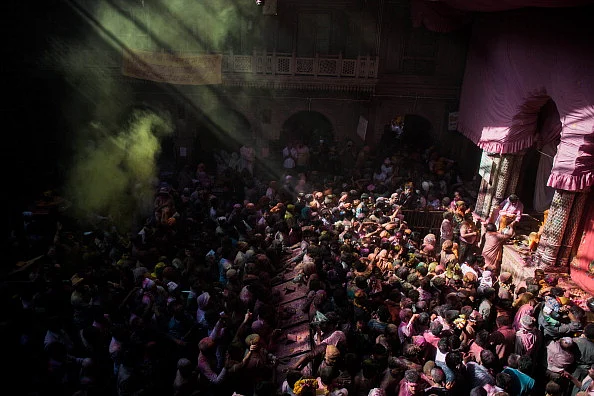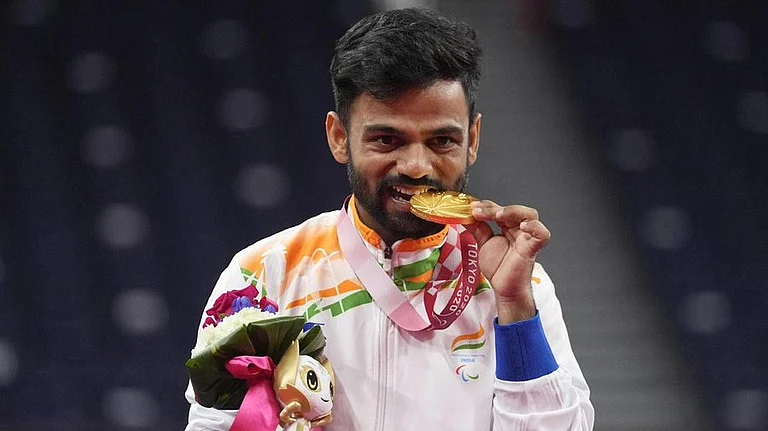Mathura and its adjoining areas of Nandgaon, Barsana, Govardhan, Vrindavan, etc. is well-known for its special kind of Holi which is played with canes and sticks, the latthmar holi. In this peculiar form of Holi, there is a central role played by the trangender and the transvestite community where men dress up as Radha, gopis, and Sakhis. As per the tradition, Krishna is the only man in the Vrindavan region, and everyone else is a woman. Thus, the men of Vrindavan identify themselves as one of the women who were a part of Krishna’s life. The tradition goes that, even when Lord Shiva himself wanted to participate in the Raasleela of Vrindavan, he had to go there in the form of a Gopi. This form of Shiva is popularly worshipped as Gopeshwar Mahadev in Vrindavan, where there is a temple dedicated to him by the same name. Across India, several saints and bhakti poets have also adopted the Gopi bhava. For example, Ramakrishna Paramhansa, who is otherwise popular as a distinguished Kali devotee, immersed himself in the Gopi bhava to the extent that he dressed, behaved, and lived as a girl for six months altogether. The Vaishanava saint poet Narsi Mehta was so immersed in Krishna’s devotion that he given up his manhood altogether, imagining himself more as a dancing and singing Gopi.
In contemporary times as well, there are such devotees galore who perform gender reversals in Krishna bhakti. Prof. Rutwij Mistri, from MS University, Baroda, who annually visits Vrindavan for Holi thus describes his first Holi experience in Vrindavan: “When I first came to Vrindavan’s Holi in 2020, it seemed to me that I am nothing but Thakurji’s (Krishna) Gopi. There were numerous Gopis of Thakurji. I certainly count myself as one of them.” He received a new name in Vrindavan: Rangili Hori Sakhi: Rangili (meaning colourful) because he wears a colourful attire; Hori because he came in the season of Holi; and Sakhi because of his cross dressing. Prof. Mistri has immersed himself in this Sakhi bhava to such an extent that he prefers to be called only as Sakhi. The Sakhi tradition is an important part of Vrindavan’s devotional scene, wherein the men regard themselves as maids and girlfriends of Radha and they relish the voyeuristic pleasure of conjugal love of their beloved God.

The Holi of Vrindavan is a several-weeks long and varied affair. Some of the variants of Holi celebrated here include the latthmaar Holi, Phool Holi, Laddu Holi, among others. It is the men of Barsana (the village where Radha belongs to) who dress up as her Sakhis and visit Nandgaon (Krishna’s village) to ritually extend the Holi invite to Krishna. The sewadar of the Sri Radha Rani Nij Mahal Kishori Shyam Goswami lays out the background thus: “The Gopis complain to Priya ji (an affectionate name for Radha) that Krishna teases them for 11 months of the year. Hence he is invited to play Holi in Barsana in the last month (i.e. Falgun) where, in an act of affectionate reprisal, he is welcomed with a barrage of lathis.” The Gopas (Krishna’s friends) guard themselves from this beating with a shield over their heads. Here, the ones doing this welcome are the married womenfolk of Barsana. Thus Krishna bhakti envisages the women as active participants rather than as passive onlookers.
The famous Holi song ‘Rasiya ko naar banao ri, rasiya ko..’ (Oh friends, let’s turn this rogue into a woman..) is an interesting example. In this song, the Gopis dress up Krishna with the traditional feminine adornments of Bajuband, Nakbesar, Kajal, Aarsi, Challa, Khangwari, Bichhua, etc. and make him dance for their pleasure. And Krishna very readily consents to perform these acts of gender transgression without any obstacle coming from his masculine ego.
After thus playing Holi at Barsana, the male Sakhis return to Nandgaon again, this time to seek Fagua (the ritual gift offered on Holi). There they go to Nandbhawan (the designated house of Krishna’s parents) and demand the fagua (Holi gift) from him. At the Rangili chowk there, the female Gopis of Nandgaon play the latthmar holi with the male Sakhis who have arrived from Barsana. One such male Sakhi explains, “All of us men are the Sakhis of Radha in female garb because men as such, are forbidden from entering this area. Even Krishna himself dwells here as a Sakhi. Whenever he had come to meet Radha here, it was always in the form of a woman: as a bangle vendor, a woman dyer, a woman goldsmith, or as a female gardener, etc..”
Transgenders’ participation in this whole set up is also very apparent. They believe that they are naturally Sakhis. Hence, unlike men, they need not change their garb and their presence during the Holi festivities is considered as very auspicious.
On Holi, many married, householder men also enthusiastically cross-dress up as Radha, Gopi, or as Sakhis. It is not really that easy for a man to adopt the Sakhi garb because of the mockery and the taunts they have to inevitably endure. One such Sakhi, who goes by the name of Purushottam Sakhi, has given up his family life altogether and has been permanently living in the Sakhi form in Vrindavan for the past 35 years, says that, “To give up fear and shame is the sine qua non of the Sakhi marga”. Indeed, it is very courageous to live freely while going against the gender norms of society. Such Sakhi devotees are of the opinion that one must approach the deity with their authentic self. If one indeed feels as a Sakhi or as a woman from within, then he must approach the lord in that very form, i.e. with his authentic feeling.
Rutwij Mistri aka Rangili Sakhi explains his feelings, “When we do our sringara, we cease to be our mundane selves. We are overcome with the spirit of Radha-Krishna and this adornment is dedicated to none except them. This sringara is our offering to them.” Hence these male Sakhis go around in veil and they bare their faces first before Thakur ji. Since this adornment (sringara) is meant specifically for him, hence he must be the first one to receive (in this case, view) it.
In the bhakti tradition prevalent at Vrindavan, Radha is accorded the same status as Krishna. By extension, the idea of effeminacy itself gets exalted in this tradition. Here we find a harmonious mélange of transgenderism, male cross dressing, and fluid masculinity, things which are otherwise regarded as taboos in society. But in Vrindavan, they become a perfectly legitimate way of devotion. When we talk about religious morality, then we ought to bear in mind the totality of our varied devotional traditions. Only then will we be able to avoid judging as immoral or transgressive, those ways of devotion which differ from ours. Besides, it would do us a world of good to not limit Krishna to the ascetic and the moral didactic figure that comes out through popular texts like the Gita or the Mahabharata itself, but also keep in mind the lived bhakti traditions of places like Vrindavan.
(Dr. Ajay Kumar Yadav is a post-doctoral scholar at the Centre for Political Studies, JNU. He can be reached at: ajaykumarjnu100@gmail.com.)























